
|   |

|   |
 e-mail: leelakaverivenkat@gmail.com Parampara Festival: Unusual jugalbandis of different regional genres of music and dance Photos: Rahul Naag December 14, 2021 It calls for more than the usual music/ dance program announcement to attract an audience for live programmes, during the pandemic. So, for the silver jubilee of the annual Parampara Festival mounted by Raja/Radha/Kaushalya Reddy's Natya Tarangini, established forty five years ago in New Delhi, was this year's unusual concept of jugalbandis comprising interactions of music, dance, percussion traditions, belonging to different regional genres. This opened out unexplored territories for artistic imagination - thereby luring audiences to the open air performance space with the galleried seating, in the home of the Reddys, braving Delhi's cold and pollution. Normally, established singers or instrumentalists known to perform in solitary glory, are not inclined, even on special occasions, to sharing the stage with dancers in a jugalbandi. That reputed artists from the music world coordinated and worked with dancers, says something about the persuasive powers of Natya Tarangini. Also, economic hardships sustained during the pandemic by the less affluent among artists in particular, the sad loss of some of the greatest of singers and instrumentalists, along with having to live for months in lone splendour within the four walls of the home, have spurted a new sense of fellow feeling and a need for sharing. 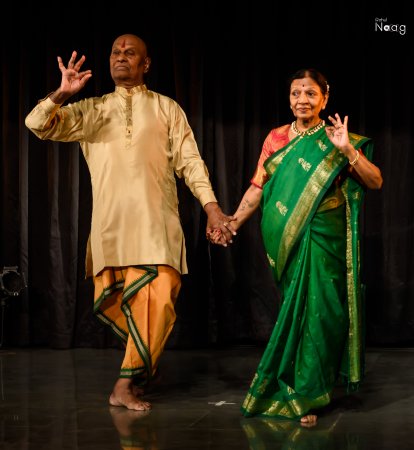 Raja and Radha Reddy  Pt Ronu Majumdar & Yamini Reddy After a brief welcome through gentle dance comprising hand gestures largely by the hosts Raja/Radha Reddy, came the first jugalbandi featuring daughter Yamini's Kuchipudi dance and Ronu Majumdar, the Hindustani music flautist - the latter having also trained, among other gurus, under Late Pt Ravi Shankar. And as one following the Maihar tradition comprising Dhrupad aesthetics characterising both aalap and jod, Ronu Majumdar's originality lies in linking layakari with this. The program began with a Swati Tirunal composition "Padumanabha tumhari lila" set to raga Bageshwari by the flautist along with both percussionists (mridangam by Manohar Balatchandirane and tabla by Mithilesh Kumar Jha) providing the rhythmics for the "Nacharahi gori ....chananana...thom". Along with the usual high spirited nattuvangam of Kaushalya Reddy, this was an inspiring combination for Yamini to delight in the customary Kuchipudi virtuosity - giving the item verve and lilt. Ronu Majumdar's mesmeric flute interventions in aalap and jod were in a class by themselves. "Chalo man Ganga Yamuna teer," the next item in Pahadi, a Meera bhajan, started off on the time worn note of the Gopi setting off for a bath in the Yamuna, engaging in jala kreeda with companions, to discover after emerging out of the water, that the garments kept under a tree were missing. Prankster Krishna perched on top of the tree demands that the Gopi, sans clothes, perform a full salutation to him, before the clothes are returned. (The episode of cheer haran is meant to be a metaphor suggesting the destroying of the Gopi's ego). Getting carried away with the variations round the line "Ganga Jamuna nirmal pani," Ronu Majumdar, a wizard with the flute, suddenly broke into spontaneous singing, certainly not of the same level as his flute playing. Yamini, given her strong rhythmic sense, responded to the improvised moments, without problems.  Pt Bhuvanesh Komkali & Gauri Diwakar That well known vocalist from a reputed family of singers, Bhuvanesh Komkali agreed to team up with Kathak dancer Gauri Diwakar, was for this critic, a supreme example of egolessness. What the presence and participation at this level of musical proficiency gave to the entire performance in terms of evoking mood, cannot be measured. It made all the difference to Gauri's presentation of 'Dancing Emptiness' based on the compositions of Kabir - considering that my first exposure to this work by the dancer had left me totally unmoved. But with the nectar and emotional appeal of Bhuvanesh's singing inspiring a dancer, whose Kathak seems to have soaked and imbibed over time, the spirit of the theme on the impermanence of life, really transported the audience. Shoonya of Kabir is not hopelessness, but a constructive nothingness, which comes from an elevated state of the consciousness. With a long golden string as a metaphor for life, which the dancer keeps pulling towards her till it ends, signified life with all the uncertainties involved -"Chaahat - nahiya chahat". Life's wants and desires unceasingly come and disappear and in changing moods comprising the navarasas (fleetingly portrayed through facial expressions). Without this never ending desire, and the main cause of all unhappiness being conquered, living becomes nothing but an endless saga of dissatisfaction. "Jeena re" in raga Bhimpalasi as rendered melodiously by the singer, throbbed with bhava, and with Gauri's dance responses, the item engrossed the audience right from the start. The next composition based on Kabir's "Chal hans baje" began with Bhuvanesh's highly evocative aalap prelude in raga Kalyan. The poet in this refers to the soul separating from the body (where the mind plays hide and seek all the time). This life force likened to a swan is urged by the poet, to fly to that wonderful land where one can secretly meet with the beloved (Jahan pia chaha chit chor). Here union stands for ultimate self realisation and becoming one with the Peer. Kabir's poetry needs to be fully understood to be spun into dance images which convey the ultimate message and philosophy of the words. And Gauri's engrossed interpretation, even in footwork, revealed an implied emotional quotient. The dancer portraying the swan with wings opening out and spreading as it travels through the sky, with the sarangi tones of Kamaal Ahmed, along with the sensitive lighting made for its own poetry - the percussion interlude on the tabla (Yogesh Gangani) and pakhawaj (Ashish Gangani), playing its part in the total effect. The finale set to Sohini "Ghungat pat kholre tohe peeva milengi", saw a swirling dancer with yards of cloth. The cloth and talk of a veil in the language of sringar are again a reference to the thick veil of ignorance one wraps oneself in and unless lifted, hides forever the truth. Only when this veil is lifted, will one discern the sounds of the inner voice which remain unheard otherwise. 'Ananda anahata dholere,' only then can one hear the drumbeats of those unheard sounds of bliss. The togetherness of singer, dancer and instrumentalists made for a memorable recital. For interpreting through pure rhythm such ideas, the Kathak dancer's ghungroo clad feet, through subtle weight changes in foot stomping, provide an excellent means. 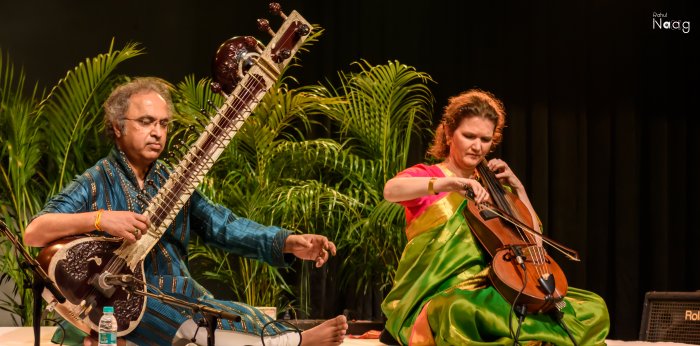 Pt Shubhendra Rao & Saskia Rao Solo Hindustani music sitarist Shubhendra Rao as a worthy student of late Ravi Shankar, and often described as a bridge between various musical cultures, is a creative experimentalist in Indian music, taking the art to many places including areas where the poorest of the poor live. His marriage to Saskia de Haas, (originally a western music cellist, who has now discovered, after her training in Hindustani music under masters like Hariprasad Chaurasia, the cello with some changes, adapted for playing Hindustani music) has led to some interesting musical forays. The couple runs a foundation, where music curriculums are formulated and extensively used for learners - their work answering their motto of 'music for all.' Choosing the king of ragas Yaman, with aalap, jod and jhala, for the starting of the Parampara festival recital, apart from the melodic treat of how well the two instrumentalists combined, what one found fascinating was watching Saskia Rao de Haas, seated cross legged, Indian fashion, playing the cello -- with the instrument, particularly in the lower octaves, sounding so much like the human voice. In the drut laya, along with Pt Ramkumar Mishra's flying fingers on the tabla, it was an unusual concert. The jugalbandi ended to the sounds of a composition in Misra Piloo. 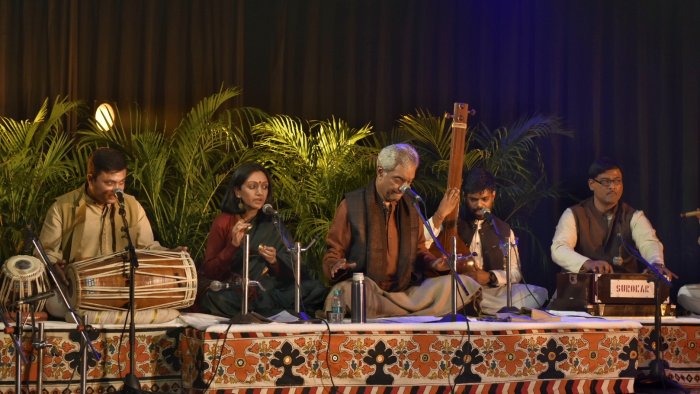 Sawani Mudgal & Pt Madhup Mudgal 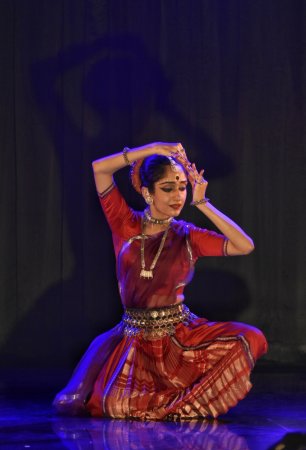 Arushi Mudgal The other memorable evening was watching the Mudgal musical family working together with Madhup Mudgal himself singing his own compositions in the Hindustani music style based on the aesthetics of Dhrupad, Khayal, Thumri and Tarana, along with daughter Sawani Mudgal supporting him. Literally dancing to their tunes in the Odissi dance form, was the second daughter Arushi to her own choreographic interpretation of the music. Also part of the instrumental support, were Srinibas Satpathy on the flute, Gurubhad Singh on the table, Khadak Singh on pakhawaj and tabla with Kushal Sharma on harmonium. As part of a family steeped in music and dance and presiding over an institution like the Gandharva Mahavidyalaya in Delhi, the togetherness of music/dance did not come as a surprise. Based on verses from Ganesh Puran, the invocation Jaya Ganesh in Dhrupad style, composed in raga Multani set to Chautal of 12 matras gave a lively start to the recital. Interspersed with a peppy Kavit and generously sprinkled with rhythmic syllables, the description of Ganesh along with his proverbial love for sweetmeat (modakapriya) concludes with the joy of his dance, culminating in a final touch of Arushi herself picking up cymbals to beat rhythm, along with her dance. The next purely interpretative Thumri type of composition Dwar based on verses in Brajbhasha, comprised a playful exchange between Radha and Krishna, the humour coming from a pun on words - with Radha knowing all along the identity of the person knocking at her door saying "Kholoji dwar", deliberately attributing the wrong meaning to words like Hari meaning monkey, and Ghan Shyam meaning clouds. Ultimately the charades end with Radha opening the door, announcing to Krishna "Eji ab to jane na doongi" (Now I won't let you go). Following the romantic interlude with Radha losing her identity, becoming one with Krishna, and finally, Radha as the swadheenapatika or the confident after-union nayika, demanding a role reversal with Krishna, that they exchange identities with 'you being adorned with my bindi and ornaments, and I becoming the flute player' (Hamre bhooshana tum sab pehero, hamare bindari tumhi lagao). The finale for the recital was "Dhirana tana" in the Tarana pattern based on rhythmic syllables in raga Hindol. But the real jugalbandhi, with no-holds-barred musical expansion, involving on-the-spot improvisations, came in the last part in Maru Behag where a deeply involved Madhup Mudgal took off on a solo journey of elaborations - which called for a dancer's quick witted, unrehearsed responses - a task for which Arushi seemed well equipped. Visibly moved by the music, her dance reflexes seemed automatic. Not surprising for a family which lives with music and dance all the time, and on the whole a very inspiring evening! 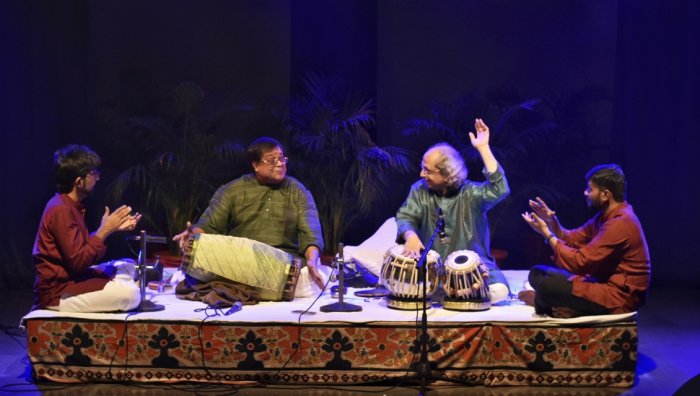 Dr. Tiruvaarur Bhaktavatsalam & Pt Yogesh Samsi Percussion had its full expression in the Carnatic/Hindustani mridangam/tabla jugalbandhi featuring Tiruvaarur Bhaktavatsalam on mridangam and Yogesh Samsi on tabla. Choice of adi talam (teental in Hindustani) provided the scope for all the improvisations one could think of - in all combinations - tisram, chatusram, khandam, misram and sankeernam combination. The percussionists were well matched. 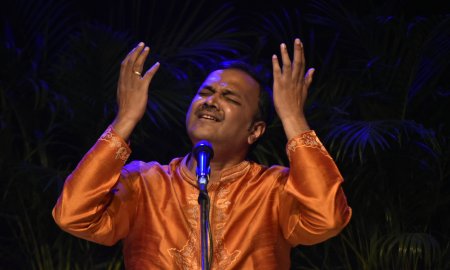 Pt. Sanjeev Abhyankar On the last evening, the unforeseen absence of the Carnatic vocalist made Hindustani vocalist Sanjeev Abhyankar the only performer. But to retain the jugalbandhi flavour of the festival, Dr. Tiruvaarur Bhaktavatsalam and Pt Yogesh Samsi joined in and made of the concert an interesting vocal/percussion interaction, ending the festival with a pure percussion sawal / jawab with the very melodious harmonium player Vinay Sharma providing a third angle to this musical interaction. From the Jasraj lineage of the Mewati gharana, Sanjeev's Khayal given his melodious voice, in raga Malkauns, delighted in sahitya full of the yearning of love in separation, "Birah setayi mohe...beete barasa juga same ....piya ke aavan", followed by the gamak laden elaborations to the line, suiting the thunder and ferocity of the words, "Garaje badarawe dolere main..". The conclusion full of the deep intensity of bhakti, "Govindam Gopala Gopi..." had echoes of Abhyankar's guru Pt. Jasraj. The last half hour and more devoted to yet another percussion jugalbandhi by the mridangam-tabla duo Bhaktavatsalam and Yogesh, despite an overkill, kept the audience interested thanks to the excellence of the two artistes. Given the last minute adjustments and the pandemic uncertainties, Parampara Festival earned plaudits for the way it was conceived and executed.  Writing on the dance scene for the last forty years, Leela Venkataraman's incisive comments on performances of all dance forms, participation in dance discussions both in India and abroad, and as a regular contributor to Hindu Friday Review, journals like Sruti and Nartanam, makes her voice respected for its balanced critiquing. She is the author of several books like Indian Classical dance: Tradition in Transition, Classical Dance in India and Indian Classical dance: The Renaissance and Beyond. Post your comments Pl provide your name and email id along with your comment. All appropriate comments posted with name and email id in the blog will also be featured in the site. |